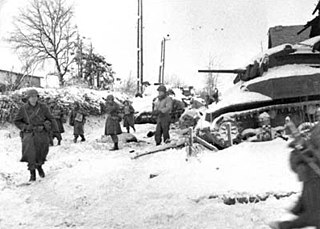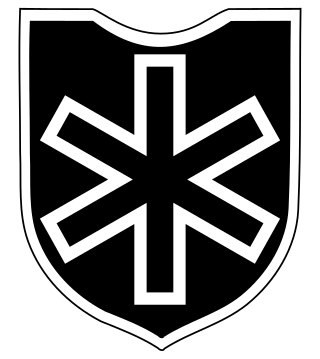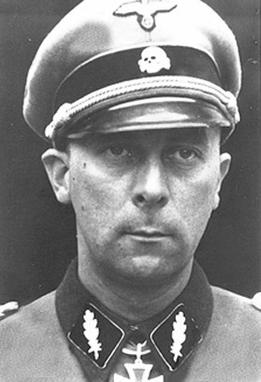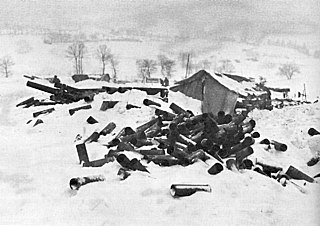
The Waffen-SS was the combat branch of the Nazi Party's paramilitary Schutzstaffel (SS) organisation. Its formations included men from Nazi Germany, along with volunteers and conscripts from both German-occupied Europe and unoccupied lands. It was disbanded in May 1945.

The Battle of the Bulge, also known as the Ardennes Offensive, was a major German offensive campaign on the Western Front during World War II which took place from 16 December 1944 to 25 January 1945. It was launched through the densely forested Ardennes region between Belgium and Luxembourg. The offensive was intended to stop Allied use of the Belgian port of Antwerp and to split the Allied lines, allowing the Germans to individually encircle and destroy the four Allied armies and force the western Allies to negotiate a peace treaty in the Axis powers' favor.

The Malmedy massacre was a German war crime committed by soldiers of the Waffen-SS on 17 December 1944 at the Baugnez crossroads near the city of Malmedy, Belgium, during the Battle of the Bulge. Soldiers of Kampfgruppe Peiper summarily killed eighty-four U.S. Army prisoners of war (POWs) who had surrendered after a brief battle. The Waffen-SS soldiers had grouped the U.S. POWs in a farmer's field, where they used machine guns to shoot and kill the grouped POWs; many of the prisoners of war who survived the gunfire of the massacre were killed with a coup de grâce gunshot to the head. A few survived.

Joachim Peiper was a German Schutzstaffel (SS) officer and war criminal convicted for the Malmedy massacre of U.S. Army prisoners of war (POWs). During the Second World War in Europe, Peiper served as personal adjutant to Heinrich Himmler, leader of the SS, and as a tank commander in the Waffen-SS. German historian Jens Westemeier writes that Peiper personified Nazi ideology, as a purportedly ruthless glory-hound commander who was indifferent to the combat casualties of Battle Group Peiper, and who encouraged, expected, and tolerated war crimes by his Waffen-SS soldiers.

The 6th SS Mountain Division Nord was a World War II mountain infantry division of the Waffen-SS, the military wing of the German Nazi Party, primarily consisting of ethnic Germans along with some Norwegian and Swiss volunteers. It was the only Waffen-SS division to operate in the Arctic Circle.

The 1st SS Panzer Division Leibstandarte SS Adolf Hitler or SS Division Leibstandarte, abbreviated as LSSAH, began as Adolf Hitler's personal bodyguard unit, responsible for guarding the Führer's person, offices, and residences. Initially the size of a regiment, the LSSAH eventually grew into an elite division-sized unit during World War II.

The SS Division Hitlerjugend or 12th SS Panzer Division "Hitlerjugend" was a German armoured division of the Waffen-SS during World War II. The majority of its junior enlisted men were drawn from members of the Hitler Youth, while the senior NCOs and officers were from other Waffen-SS divisions.

Wilhelm Mohnke was a German military officer who was one of the original members of the SchutzstaffelSS-Stabswache Berlin formed in March 1933. Mohnke, who had joined the Nazi Party in September 1931, rose through the ranks to become one of Adolf Hitler's last remaining general officers at the end of World War II in Europe.

The 5th SS Panzer Division Wiking or SS Division Wiking was an infantry and later an armoured division among the thirty-eight Waffen-SS divisions of Nazi Germany. During World War II, the division served on the Eastern Front. It surrendered on 9 May 1945 to the American forces in Austria.

The I SS Panzer Corps was a German armoured corps of the Waffen-SS. It saw action on both the Western and Eastern Fronts during World War II.
The 7th Panzer Division was an armored formation of the German Army in World War II. It participated in the Battle of France, the invasion of the Soviet Union, the occupation of Vichy France, and on the Eastern Front until the end of the war. The 7th Panzer Division is also known by its nickname, Ghost Division.

The Battle of Losheim Gap was fought in the Ardennes, in Eastern Belgium, between the Allies and Nazi Germany, part of the Battle of the Bulge. It was the first battle and spearhead of the German attack, inflicting heavy American casualties, and causing disorder on the frontlines. It paved the way for further German attacks, deeper into the Ardennes. The Americans suffered high casualties, but could replace them. The Germans, on the other hand, couldn't replace their men, as all reserves were directed to the counter offensive. This reflected the poor state that the German Army was in at this time, which would be the precedent for the following battles.

The Battle of Elsenborn Ridge refers to the northernmost German attacks during the Battle of the Bulge. The area from Elsenborn Ridge itself to Monschau was the only sector of the American front line attacked during the Battle of the Bulge in which the Germans failed to advance. The battle centred on the boomerang-shaped Elsenborn Ridge east of Elsenborn, Belgium. In this region, Elsenborn Ridge marks the westernmost ridge of the Ardennes, rising more than 2,000 feet (600 m) above sea level; unlike the uplands further north, east and south, it has been extensively logged. West of Elsenborn Ridge, where the land descends in gentle hills to the cities of Liège and Spa, was a network of Allied supply bases and a well-developed road network. The Germans planned on using two key routes through the area to seize Antwerp and force a separate peace with the United States and Britain. Capturing Monschau, the nearby village of Höfen, and the twin villages of Rocherath-Krinkelt just east of Elsenborn Ridge, were key to the success of the German plans, and Hitler committed his best armored units to the area.

The 29th Waffen Grenadier Division of the SS also Legione SS Italiana was an SS formation of Nazi Germany during World War II. It was originally created in the Italian Social Republic in 1943 as the Italian Legion, later renamed to a brigade. The unit was upgraded to division status on 10 February 1945.

Operation Martlet was part of a series of British attacks to capture the French town of Caen and its environs from German forces during the Battle of Normandy of World War II begun by the Allies. It was a preliminary operation undertaken on 25 June 1944 by XXX Corps of the British Second Army, to capture Rauray and the area around Noyers. The attack was to protect the right flank of VIII Corps as it began Operation Epsom, an offensive into the Odon Valley west of Caen, on 26 June. The 50th (Northumbrian) Infantry Division and the 49th Infantry Division were to capture Juvigny-sur-Seulles, Vendes and Rauray, to prevent German counter-attacks against VIII Corps from the area of the Rauray Spur and then extend the attack towards Noyers and Aunay-sur-Odon. It was the first time in Normandy that the 49th Division operated as a division.

The Battle of Lanzerath Ridge was fought on December 16, 1944, the first day of the Battle of the Bulge during World War II, near the village of Lanzerath, Belgium, along the key route for the German advance on the northern shoulder of the operation. The American force consisted of two squads totalling 18 men belonging to a reconnaissance platoon and four forward artillery observers, against a German battalion of about 500 paratroopers. During a day-long confrontation, the American defenders inflicted dozens of casualties on the Germans and delayed by almost 20 hours the advance of the entire 1st SS Panzer Division, the spearhead of the German 6th Panzer Army.

This is a sub-article to Battle of Narva.
The 113th Panzer Brigade was a tank formation of the German Army in World War II. As a tank formation, it was part of the Panzer Arm (Panzerwaffe).
Panzer Brigades were formations in the German Army during World War II.

Operation Southwind was a German offensive operation on the Eastern Front in Hungary, from 17–24 February 1945. The Germans succeeded in eliminating the Soviet bridgehead on the west bank of the river Hron in preparation for Operation Spring Awakening. This was one of the last successful German offensives in the Second World War.
















